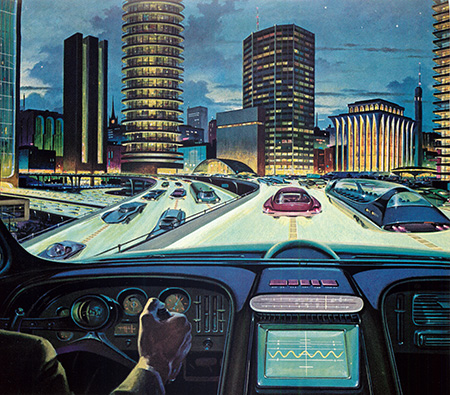
Slide behind the wheel of this dreamboat. Push the electronic control button. Then sit back and let transistors take over.
There’s something curiously tentative about this vision of the future of motoring, as seen from 1964. You’re invited to push the button and let the transistors take over. But you’ve still got your hands on the wheel; apparently you’re still responsible for driving the dreamboat.
Other early discussions of automatic automobiles are also fuzzy about exactly who or what is in charge. A notable example is the General Motors Futurama exhibit at the 1939 Worlds Fair in New York. “Safe distance between cars is maintained by automatic radio control,” intones the narrator, above creepy organ music. This certainly suggests something other than seat-of-the-pants driving. But the next sentence narrows the scope of that automatic control: “Curved sides assist the driver in keeping his car within the proper lane under all circumstances.” Thus the technology is merely assistive, not autonomous. And what’s that about “curved sides”? Norman Bel Geddes, the designer of the exhibit, explains all in Magic Motorways, published in 1940. It’s very low-tech. Freeway lanes are to be separated by high curbs of concave cross-section, which deflect a straying car back into its lane. (Later in the book Bel Geddes also discusses more elaborate guidance systems, involving buried conductors.)
The reprise of Futurama at the 1964 World’s Fair—an exhibit that I attended, along with 29 million other people—was even vaguer about the question of autonomous vehicles. We saw lots of miniature automobiles moving in close order along gleaming freeways, and personally I came away with the impression that all those vehicles were under computer control. But the transcript of the narration includes only a single sentence on the topic, and it’s open to almost any interpretation: “Vehicles electronically paced, travel routes remarkably safe, swift and efficient.”
Why so coy about the prospect of cars that would drive themselves without human intervention? Maybe the concept was just too outlandish for credibility, particularly in 1939. Or maybe GM recognized that their natural audience is made up of car enthusiasts, who want to drive their dreamboats, not just be carried along as electronically paced, radio-controlled passengers.
In any case, the coyness has now evaporated, and these days everybody is talking about truly autonomous vehicles. DARPA runs contests for them; an Italian group has driven them across Europe and Asia; Google has a “secret” fleet of them. And I too am talking about autonomous vehicles: “Leave the Driving to It” is my latest American Scientist column.
Note: The artwork above is from an RCA advertisement in the September 1964 issue of Scientific American. Stylistically, the painting owes something to the Futurama exhibits, but I’d like to make a wild guess that the (uncredited) artist who created this rendering lived in Minneapolis. That brightly lighted, colonnaded building to the right of center looks to me very much like a building at Hennepin and Washington (now owned by ING) that was completed in 1964, just as this ad appeared. The architect was Minoru Yamasaki, the designer of the World Trade Center.